This post is part of a larger deep dive
Curious about the role of the Spanish Civil War and "The Consequences of War" by Peter Paul Rubens in Guernica? Check out Guernica Explained!
Or read the full Guernica article!
This post is part of a larger deep dive
Curious about the role of the Spanish Civil War and "The Consequences of War" by Peter Paul Rubens in Guernica? Check out Guernica Explained!
Or read the full Guernica article!
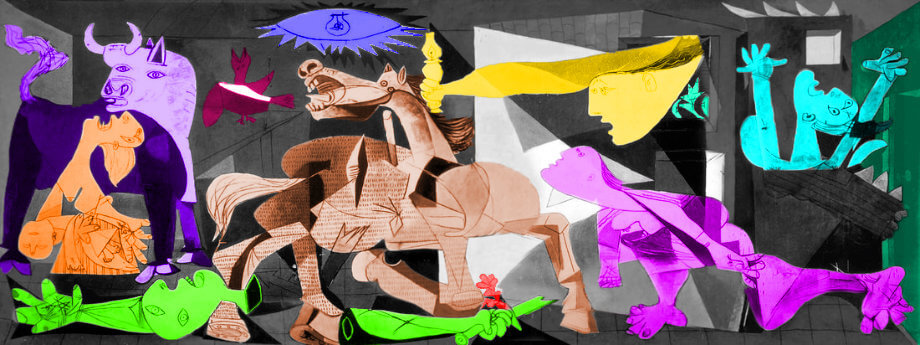
In this analysis, I decided to dissect Guernica into its main constituents and draw a parallel to Rubens’ characters in his “The Consequences of War”. Even though most of the ideas in this article are based on the book “Picasso’s Guernica after Rubens’s Horrors of War” by Alice Doumanian Tankard, some of my interpretations will differ from Tankard’s.
It’s interesting that Picasso initially placed most characters in the position the characters in Rubens’ work appear. For example, the woman with stretched arms, who appears to be the equivalent of Europe in Rubens’ painting, was initially drawn on the left side of the canvas.
Later Picasso decided to flip their positions in the canvas, the reasons for which are not entirely clear. Did Picasso intend to make the link between Guernica and “The Consequences of War” less conspicuous?
In the sections below, the titles will indicate a character in Rubens’ painting on the left side of the hyphen, and the homologous element in Picasso’s work on the right side of the hyphen (e.g., Mars – Light bulb).

The Venus in Rubens’ painting bears many similarities with the bent woman on the right of Picasso’s work (see images above).
Both are mostly nude, their hairs are pushed back, a veil is visible on their backs, and both are striding towards the centre of the painting.
In Rubens’ work, Venus is looking at, and leaning on, Mars. In Picasso’s painting, the woman is looking in the direction of the light bulb, which, as I’ll argue below, is a symbolic war figure just as Rubens’ Mars.
Another interesting parallel is that both women are showing grit and determination in ending the war. Just as Venus in Rubens’ work tries to put an end to Mars’ rampage, so is Picasso’s woman pursuing the destructive light bulb despite her injured leg, as if intent to put a stop to the devastation the bulb (war) is causing.
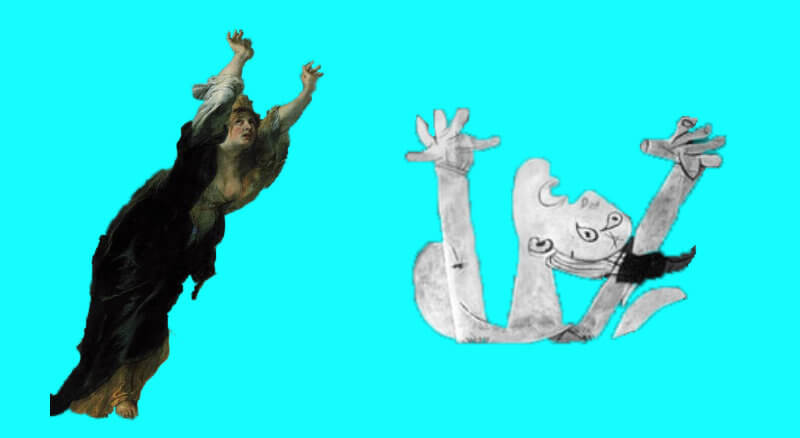
In Picasso’s painting, the female figure with stretched arms is likely the analogous of Rubens’ Europe. In both works, her heads are flung back, arms stretched up, eyes rolled up and mouth agape.
It’s just about visible tears forming in Rubens’ Europe. In Picasso’s work the woman with arms strechted up has eyes in the shape of tears.
Furthermore, in Picasso’s work, this woman has a kind of hat on her head, mimicking the crown worn by Rubens’ Europe.
Also, note the shape of the right hand of Picasso’s “Europe”. It appears to be an airplane, perhaps Picasso’s subtle clue that links this painting to the Nazi bombers that destroyed Guernica.
Finally, it is interesting that Picasso chose “Europe” to be one of the most shocking elements of the painting (a woman being burned alive). Picasso was probably foreseeing the terrible consequences fascism would have on much of Europe.
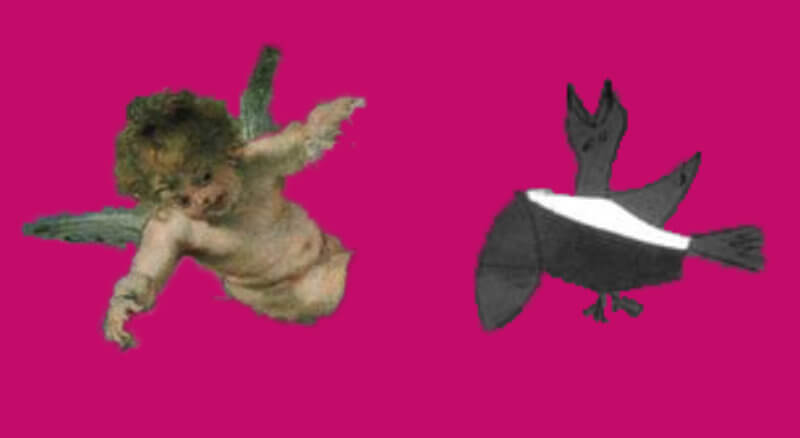
Rubens painted a Cupid above Venus, trying desperately to help her in her efforts to appease Mars. In Picasso’s painting, there is no Cupid, but Picasso drew a wounded dove between the horse and the bull.
In classical art, the dove symbolises the holy spirit as well as a symbol of peace. With this detail, Picasso meant that peace is all but destroyed by war, just as Cupid ultimately fails to halt Mars’ turmoil and maintain peace.
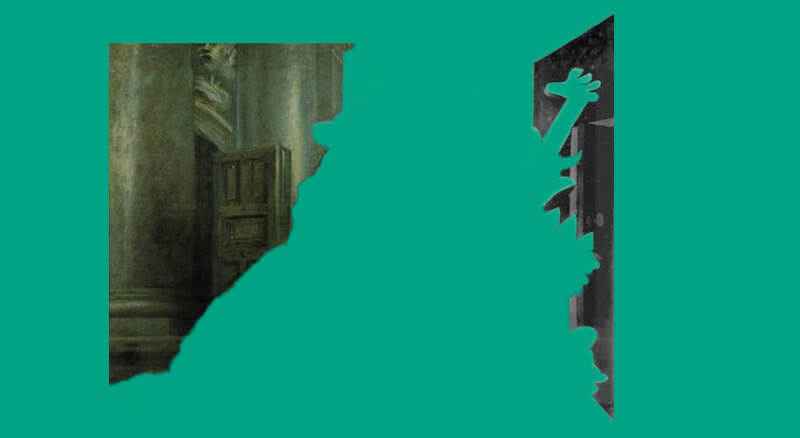
In Rubens’ painting the temple of Janus is just visible behind Europe. In Guernica, “Europe” is also standing behind what it looks like an open door.
Above the gate of the temple, Rubens painted a niche containing the two-faced bust of Janus. In Guernica, a small window is shown at the left of the door, although no bust is present.
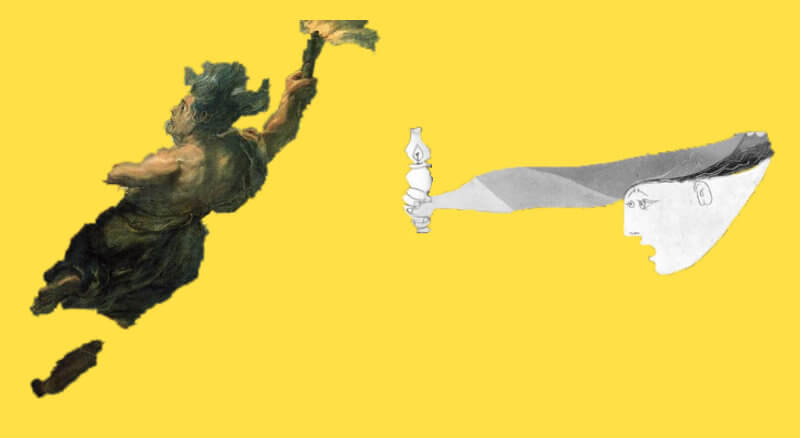
In Guernica, we see a woman with her left side of her face turned towards the viewer, her mouth is agape, eyebrows are raised, eyes wide open, just like Rubens’ Alecto. Also, the hair streams of Picasso’s figure resemble the chaotic hairs of Rubens’ Alecto.
Interestingly, the woman in Picasso’s painting isn’t inciting violence, which stands in stark contrast to Rubens’ Alecto, who is egging on Mars. Instead, she comes through a window into the battle, and her facial expression is of shock and horror by what she is witnessing.
There have been suggestions that this woman may represent Russia, mostly because the signs just under her neck resemble a hammer and sickle, a well-known communist symbol. The kerosene lamp would, then, symbolise the help Russia provided the Republicans.
By transforming Alecto from a vengeful and instigator figure into a compassionate and full of hope character, Picasso perhaps hoped that the war would come to an end, and the Republicans would come out victorious.
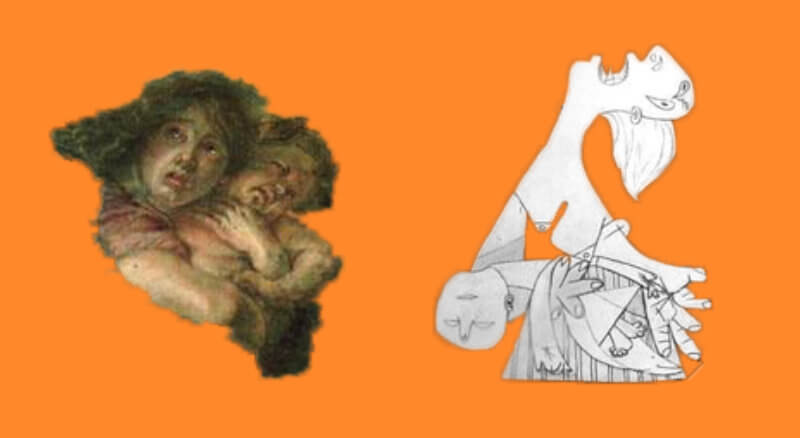
In both Picasso’s and Rubens’ works, there is a woman carrying a child on her arms. Both mothers have their mouths wide opened, while their faces are turned upwards in horror. Furthermore, the child appears to be dead, or unconscious, in both Rubens’ and Picasso’s paintings.
This figure is perhaps the most dramatic of the entire painting, and at the same time, the most pertinent. The bombing of Guernica was a brutal attack on unarmed civilians, most of whom were women and children, as men were fighting away for the Republicans.
With this element, Picasso wished to depict the suffering of women and children from the horrors of the bombing.
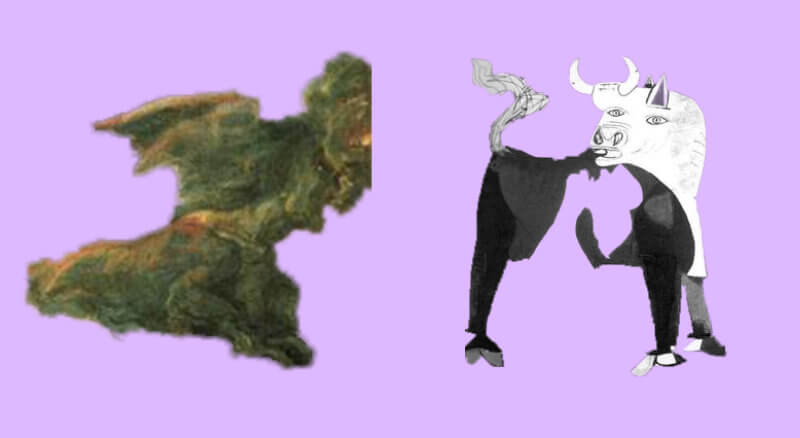
In Rubens’ painting, the monsters of Pestilence and Famine appear behind the woman carrying a child. In Picasso’s painting, a bull is shown behind the woman with the child.
As with many of the other figures, the Bull is positioned in mirror image to Rubens’ Pestilence. Both monsters in Rubens’ painting have their mouths opened in a threatening pose, just as the Bull in Picasso’s painting.
Pestilence is often depicted as a hybrid creature: half human, half animal. It’s interesting to note that Picasso drew a hybrid creature with a human face and a body of a bull in early drawings of Guernica.
Picasso once mentioned that the Bull represents darkness, coldness and cruelty. Perhaps Picasso intended it to be a representation of Fascism, or of Francisco Franco himself.
Also, play close attention to its tail. It’s giving off smoke, perhaps a symbolism of the smoke emanated from the fires caused by the bombings.
Moreover, in some sketches Picasso made of Guernica, the Bull is depicted raping the female figure, indicating that the Bull is a representation of evil.
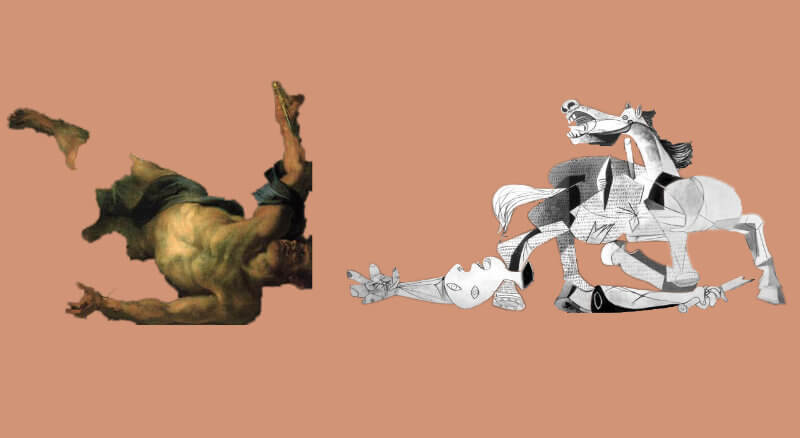
Picasso reserved the center of his painting to the horse. The horse is severely wounded (a deep cut is visible on its body). The mouth is opened wide and the tongue is sticking out, suggesting that it is experiencing extreme pain.
The fallen soldier with a severed arm is holding a broken sword on his right hand. There is an obvious parallel here with the Architect in Rubens’ painting. Both are lying on the ground, eyes are opened but empty, as if unconscious. Their left hands are empty, but their right hands are holding the instrument of their profession (the architect, a compass; the soldier, a sword).
Both the horse and its soldier likely represent the Republicans, and their courage to put a stop to the madness of war. Note how the horse is turning his head towards and shrieking at the impassive bull, as if it were the last sacrifice. Also, note how the sword has been broken in half, perhaps a representation of defencelessness.
It is also important to consider the relationship between the Bull, the soldier and the horse. Bullfighting was (and still is) a typical Spanish tradition. The soldier with a broken sword could represent a matador. But whereas bull fighting usually ends with a victorious matador, in Guernica it is the matador and his horse who are slaughtered.
Perhaps, with this twist, Picasso wished to shake viewers up, making them aware of the desecration Franco and his fascist allies were commiting in Spain.
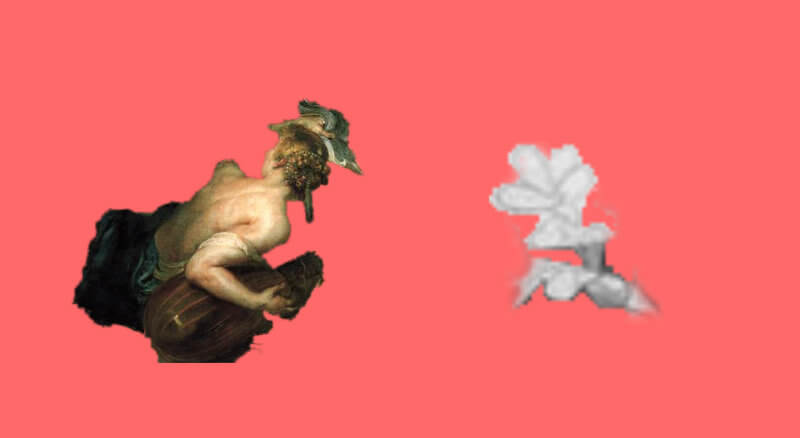
In Ruben’s painting, between the Architect and Venus, we can see Harmony lying on the ground, holding a broken lute. Harmony is the goddess of, well, harmony and concord.
In Picasso’s work, we can see a poppy between the fallen soldier and the woman with an injured leg. Why a poppy, out of all things?
Well, white poppies are flowers that came to symbolise peace. In fact, this symbolism was beginning to emerge at pretty much about the time Picasso was working on Guernica.
So, Picasso’s poppy represents a ray of hope that not all is lost, and peace (concord) is still attainable.
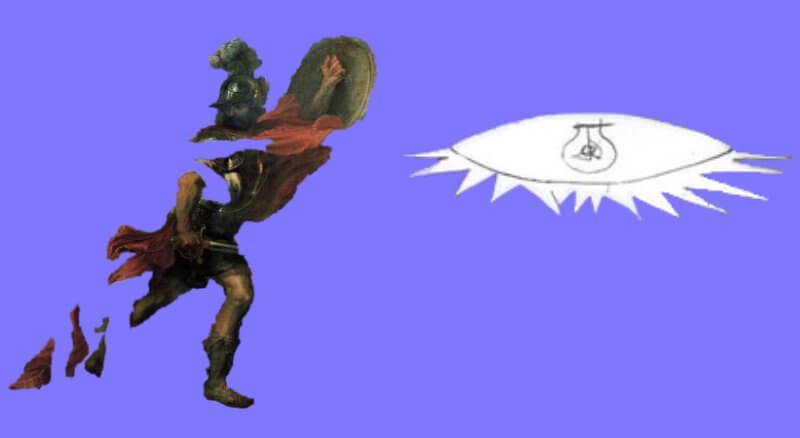
There is no male figure in Picasso’s painting that can be directly related to that of Rubens’ Mars.
However, I would like to draw your attention to the light bulb at the top of the painting. This is one of the most intriguing elements in Guernica, which has received at least two contrasting interpretations.
First, because it has a shape of an eye, many art experts interpreted it as the eye of God looking down on the horrors of the war. The reason for this is that, classically, whenever light was present, it would usually represent the presence of God.
The second interpretation of the light bulb is that it represents the destructive technological weaponry used in the war. The word for bulb in Spanish is “Bombilla” which is similar in sound to the word “Bomba” (bomb in English).
Rather than thinking of the light bulb in terms of either the first or second interpretation as it’s often done, I believe that the two interpretations are not mutually exclusive. Perhaps a case could be made that the light bulb is the universal engine of war, prepared to run amok in the places it visits. In other words, Mars.
As noted by Tankard in her book, Picasso placed a directional arrow in more or less the same position where a set of arrows are located in Rubens painting. “Flecha” is the spanish word for arrow, and just as the English word, “flecha” can be used in both contexts: for shooting arrows (as in Rubens’ painting) and as directional arrows (as in Picasso’s painting).
The smoke that permeates the background of Rubens’ painting has been replaced by flames in Picasso’s painting.
Guernica’s anti-war message is very potent, and the painting has, deservedly, become an icon in anti-war movements across the world.
In this article, I focused on the similarities to Rubens’ “The Consequences of War”, showing how almost every figure in Picasso’s work has a potentially corresponding element in the allegorical work of Rubens.
Rubens’ Mars and Picasso’s lightbulb as the engine of War; Rubens’ Venus and Picasso’s injured woman courageously attempting to stop war; Rubens’ Europe and Picasso’s woman in the burning building as a symbolism of the devastation caused by war; Rubens’ fallen architect and Picasso’s fallen soldier, as brave martyrs of the war; Rubens’ Harmony and Picasso’s poppy as longing for peace; Rubens’ monsters and Picasso’s Bull as the scourge of war.
Indeed, just as Rubens’ “The Consequences of War” was produced as a response to the Thirty Years War that caused so much affliction in Europe, Guernica is the contemporaneous response of a tragic event that caused so much suffering and decided the course of the Spanish Civil War.
Unfortunately, apart from the message, not much more excites me about this painting. Aesthetically, I find Guernica lacklustre. Its impressive dimensions cannot conceal the fact that it was a rush job, and the lack of proper references to works that most likely influenced Picasso is regrettable (although, to be fair, there is no proof that Picasso really based his painting on “The Consequences of War”, or any other painting for that matter).
No doubt Picasso was a terrific painter who had mastered classical techniques from a very early age. I find some of his earlier works impressive, but Guernica… I feel the hype has more to do with Picasso’s exceptional ability to self-promote.
Notwithstanding the striking similarity between Rubens’ “The Consequences of War” and Picasso’s Guernica, it would be naive to conclude that Rubens’ work served as the only inspiration for Picasso’s painting.
In fact, Guernica was likely inspired by a many great deal of paintings, among which The Consequences of War would just be one of them. For example, Goya’s “El tres de Mayo”, Michelangelos Pieta, Rafael’s The Fire of the Borgo, Caravaggio’s Conversion of St. Paul, just to name a few, have all been proposed as precursors of Guernica.
A compendious analysis of all these works and their relationship to Guernica would probably require several volumes, so my efforts centered on Rubens’ work, which I believe reverberates more strongly in Guernica.
See you in the next article!
Books
Tankard, Alice Doumanian. Picasso’s Guernica after Rubens’s Horrors of War.
Documentaries
World War II in HD Colour – episode “The Gathering Storm”
Youtube
About Picasso’s Guernica
About Rubens’ “The Consequences of War”
About the Spanish Civil War
Leave a comment
Add Your Recommendations
Popular Tags